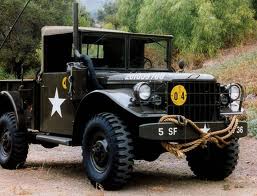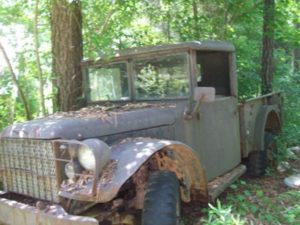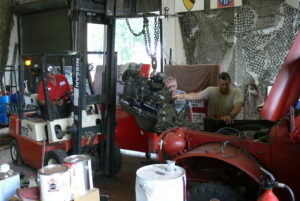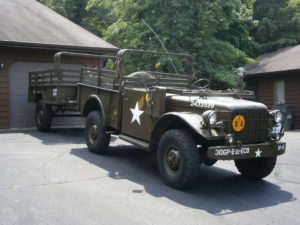History
M-37 3/4 ton Dodge Truck
Designed and built by the Dodge Motor Company from 1951 to 1968 the M37 represented the epitome of the military 3/4 Ton service truck. Based on the famous WWII WC 51 Weapons’ Carrier design, the M37 saw service in Korea, Vietnam and into the late 1970’s with the US military and other militaries throughout the world. Not especially known for its speed (55 MPH) it became legendary for carrying eight fully equipped troops and tremendous amounts of weight (1 ton+) over rough terrain and cross-country. Unfortunately many of these vehicles have been scrapped for their axles which are modified and used in rock-crawling trucks.
Do you have a veterans story or pictures you would like to submit?

The Dodge M37 ³⁄₄-ton 4×4 truck was Dodge’s follow-up to their successful Weapons Carrier (WC) Series from World War II. Introduced in 1951, it was used extensively by the United States armed forces during the Korean and Vietnam war and well Into the 1970s.
RECOVERY
M37 3/4 Ton Truck
Discovered my 1st M37 (1 of 3) siting beside a barn in Tuscaloosa Alabama in April of 2011, it was purchased for $400 from the farmer that owned and parked it there after the engine locked up. It had been sitting so long that a tree had grown up between the frame and rear bumper. Luckily for me, it had a valid title although it had not been licensed for more than 20 years. Towed back to Georgia (Fort Benning) restoration work began immediately.

Sitting beside a barn for 20 Years, trees had grown up between the frame and the rear bumper. She had been purchased for a restoration project from the US Forest Service in 1983 after being retired from the US Army in 1976. In total she served 33 years between the US Army and the US Forest Service.
RESTORATION
KEEPING IT ORIGINAL
During the process of examining the M37, it was determined that the engine was not only frozen but that the block and head were cracked, It was apparent that the coolant had run out of the engine through a rusted out freeze plug and it was basically destroyed by overheating. All of the other component’s, starter, generator, carb, radiator etc. were in great shape. A complete engine, transmission and transfer case were located for $800 in Mississippi. After sandblasting the entire vehicle, the engine, transmission and all components were rebuilt. She was painted her original Korean war color and restored to running condition to include her original 24-volt electrical system. The only original item not used were the Non-Directional Tires (NDT) as modern Michelin tires were substituted for a safer ride. The M37 was dedicated as a tribute vehicle to my dad Tony, an Army Combat Engineer who would have used this exact type of vehicle during the Korean War.
Learn more about the African Queen Preservation Program

After sandblasting the body I found very little rust damage and it was easily repaired by replacing the rusted out section with new metal. The engine was a total write-off and a replacement was located in order to complete the restoration.
Preservation
Driving HER COAST TO COAST
After finishing her restoration, the M37 joined 30+ vintage military vehicles for a coast to coast convoy from Washington D.C. to San Diego CA in Aug 2015. The convoy honored the 90th anniversary of the famous Bankhead Military Convoy of 1925. The M37 covered the 3000+ miles in 30 days with absolutely zero mechanical issues proving once again the resiliency of these magnificent Dodge trucks.
This vehicle and trailer have now joined a military vehicle collection in California and the AQProject has two additional M37 winch models that will now become future restoration projects.

I dedicated my restored M37 as a tribute vehicle to my dad Tony, a combat veteran of the Korean War, as this was exactly the type of vehicle he drove in Korea.
LTC Mark A.R. Koloc US Army (Ret)